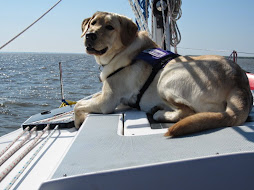 SSD Onyx spent her Christmas stalking two Dalmatians. Her puppy raisers aren't sure where or how she learned it, but Onyx sneaked up on the two Dalmatians who were visiting for the holidays. She moved slowly, getting closer, closer...then POUNCE! She jumped on them. Neither Dalmatian was especially fond of being jumped on. After getting pounced a few times, the one decided that the best way to avoid Onyx's sneak attacks was to keep moving. The other took a more direct approach and simply growled at the little lab when he had had enough.
SSD Onyx spent her Christmas stalking two Dalmatians. Her puppy raisers aren't sure where or how she learned it, but Onyx sneaked up on the two Dalmatians who were visiting for the holidays. She moved slowly, getting closer, closer...then POUNCE! She jumped on them. Neither Dalmatian was especially fond of being jumped on. After getting pounced a few times, the one decided that the best way to avoid Onyx's sneak attacks was to keep moving. The other took a more direct approach and simply growled at the little lab when he had had enough.Onyx is one of the three service dogs-in-training that we are going to be following on the blog. We will give you a window into her life as she learns different skills and behaviors and grows from a playful puppy to a skilled service dog ready to assist her partner. Look for weekly posts about her, SSD Aladdin and SSD Nubble.
You may remember Onyx from the Puppy Cam. She comes from the Crayon litter, born on September 3, 2009. She joined her puppy raisers on October 31, 2009. When they first got her, this little black lab weighed just under 13 pounds. She was just at the vet last week with her brothers Rusty and Denim, and she weighed 29 pounds. She's growing quickly!
Onyx is one smart puppy, and every day is an adventure with her. She's always exploring and experimenting with behaviors and her surroundings. Her puppy raisers can sometimes see the wheels turning in her head. One day, she picked up her food dish and dragged it from its usual spot all the way upstairs. Now, the SSD Puppy Raiser Manual says to feed the dogs in different rooms of the house, so they get used to eating anywhere. Well, Onyx seems to have taken this to heart. It's as if she was saying, "Today, I'm eating up here!"
She also loves to steal shoes. Her puppy raisers have had to move all their shoes o
 ut of reach to keep them from being chomped. However, they don't want to completely discourage her from playing with shoes because someday she may have to retrieve her partner's shoes. If she learns as a puppy that shoes are bad, it will be much harder for her to learn to retrieve shoes as an adult dog in advanced training. Her puppy raisers have been practicing leave it and then substituting something else, such as a chew toy, for the shoe.
ut of reach to keep them from being chomped. However, they don't want to completely discourage her from playing with shoes because someday she may have to retrieve her partner's shoes. If she learns as a puppy that shoes are bad, it will be much harder for her to learn to retrieve shoes as an adult dog in advanced training. Her puppy raisers have been practicing leave it and then substituting something else, such as a chew toy, for the shoe.And Onyx certainly loves to chew! It seems to be one of her favorite things to do. In fact, that seems to be the favorite thing for all the puppies in the Crayon litter. Onyx will chew on things that just don't make any sense to her puppy raisers - the legs of a metal coffee table or a brick fireplace. To stop her from chewing on things like this, they have been using the leave it cue, just like they do with the shoes. Except that Onyx is smart and has a mind of her own. Not two minutes after getting a treat for giving a good leave it, she goes right back to chewing. In her mind, it must seem like a really cool game. It's as if she's thinking, "If I chew on this, they'll tell me to leave it, and when I do, I'll get a treat. So if I chew on this table, I'll get a treat. I like this game!"
Her puppy raisers are working on keeping her from chewing things she isn't supposed to be chewing. They're also focusing on leave it and making it productive so that she doesn't go right back to what she was doing.
They're also working on recalls. Recently, Onyx had her puppy evaluations, where SSD's trainers ask each puppy to demonstrate certain skills. Onyx, however, was having none of that. She was more interested in chewing the carpet than in retrieving a ball, and she certainly didn't want to come when called, especially when there was something much more interesting to do - chew! Even though Onyx does a recall at home in a familiar environment, she still has trouble if there are distractions. For example, she loves to play with the neighbor's dog, a bulldog named Casper. She loves it so much, that when her puppy raisers call her to come, she ignores them. In order to recall her, they have to call Casper, and Onyx follows him over. Since this is the first time they're raising an SSD puppy, her puppy raisers turned to our trainers and other puppy raisers for advice. Here is some of their advice:
With Onyx, the real trick was finding the right motivation. While she likes her regular treats (her food or cheerios), they just weren't a powerful enough motivator to get her to abandon the fun thing she was exploring. You could practically hear her thoughts: "Go get some cheerios, or stay here and watch these birds flying? Ha! I'm watching the birds." But when another puppy raiser suggested using cheese
Practice frequently, but start small. Since she has difficulty with recalls when there are distractions, start with a very small distraction and build up over time as she gets better. When you're practicing outside, use an extra long lead so she stays safe while still being free to roam. When she does ignore the distractions and come when called, give her a jackpot of treats. She'll start to think, "Ooo, if I come when they call me, I'll get lots of tasty treats!" Finally, to make sure that she keeps giving a good recall, cue her to come, give her lots of treats, then let her go back to whatever fun, exciting thing she was doing (as long as it's safe). That way, come won't always mean that the fun ends. It will mean "come get tasty treats, then go back and have more fun."
 whiz - wow! What a difference! Now Onyx will voluntarily recall herself when she knows her puppy raisers have a can of cheese whiz. They haven't tried the cheese whiz when they're recalling her from playing with Casper yet. We'll let you know if it works.
whiz - wow! What a difference! Now Onyx will voluntarily recall herself when she knows her puppy raisers have a can of cheese whiz. They haven't tried the cheese whiz when they're recalling her from playing with Casper yet. We'll let you know if it works.She also loves chicken. Her puppy raisers discovered her love of chicken one day while cutting some at the kitchen counter. They had been working on different cues with Onyx, such as sit and down. When the chicken came out, she voluntarily gave a down. It's all about finding the right motivation.
Next week, Onyx will be spending a week with her brother Denim and his puppy raiser. It will be interesting to see how they interact and what they teach each other. Will Onyx learn some tricks from Denim? Check back in the next two weeks to find out.
We wish you and your four-legged friends a happy New Year!























